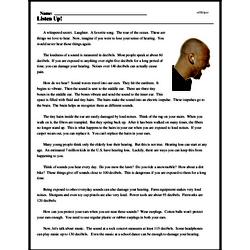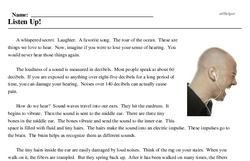Listen Up!
A whispered secret. Laughter. A favorite song. The roar of the ocean. These are things we love to hear. Now, imagine if you were to lose your sense of hearing. You would never hear those things again.
The loudness of a sound is measured in decibels. Most people speak at about 60 decibels. If you are exposed to anything over eight-five decibels for a long period of time, you can damage your hearing. Noises over 140 decibels can actually cause pain.
How do we hear? Sound waves travel into our ears. They hit the eardrum. It begins to vibrate. Then the sound is sent to the middle ear. There are three tiny bones in the middle ear. The bones vibrate and send the sound to the inner ear. This space is filled with fluid and tiny hairs. The hairs make the sound into an electric impulse. These impulses go to the brain. The brain helps us recognize them as different sounds.
The tiny hairs inside the ear are easily damaged by loud noises. Think of the rug on your stairs. When you walk on it, the fibers are trampled. But they spring back up. After it has been walked on many times, the fibers no longer stand up. This is what happens to the hairs in your ear when you are exposed to loud noises. If your carpet wears out, you can replace it. You can't replace the hairs in your ears.
Many young people think only the elderly lose their hearing. But this is not true. Hearing loss can start at any age. An estimated 7 million kids in the U.S. have hearing loss. Luckily, there are ways you can keep this from happening to you.




